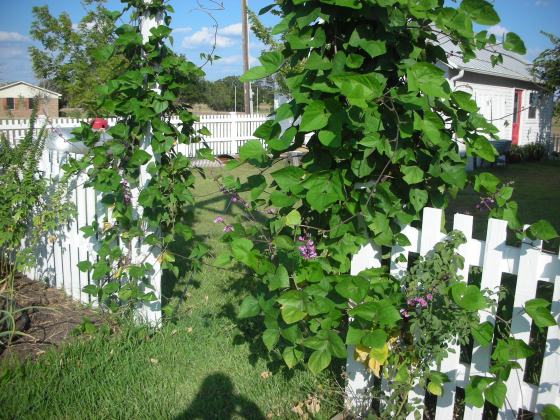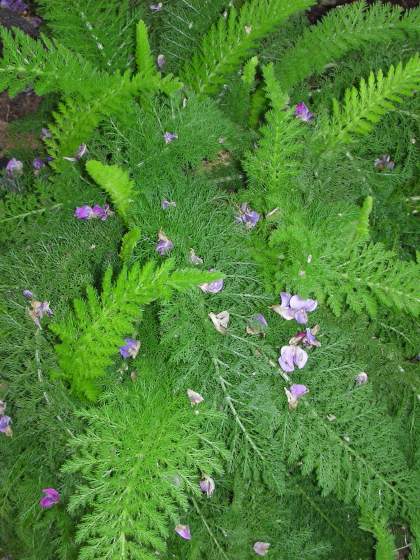 Even though it is the middle of December, my little potager has never looked better. This is one of the reasons I love living in Texas. Because of the mild winters, I can literally garden year round. Everyone loves to complain about our hot summers. However, in my opinion, our winters more than make up for it. I heard last night that Houston averages 16 days per year below freezing. We are about 90 miles north of Houston but I am willing to bet we only have 20 to 24 days that are that cold. Due to this, with proper crop selection, some rotational planting and the willingness to occasionally cover things up, your fall garden can last right up to the spring planting. Below are several pics of the things that are currently growing in my potager:
Even though it is the middle of December, my little potager has never looked better. This is one of the reasons I love living in Texas. Because of the mild winters, I can literally garden year round. Everyone loves to complain about our hot summers. However, in my opinion, our winters more than make up for it. I heard last night that Houston averages 16 days per year below freezing. We are about 90 miles north of Houston but I am willing to bet we only have 20 to 24 days that are that cold. Due to this, with proper crop selection, some rotational planting and the willingness to occasionally cover things up, your fall garden can last right up to the spring planting. Below are several pics of the things that are currently growing in my potager:
 I have three different varieties of broccoli growing in my garden.
I have three different varieties of broccoli growing in my garden.
 I have 12 cauliflower growing. I planted the cauliflower in blocks of three two weeks apart. This way I don’t have to worry about eating 12 cauliflower in one week!
I have 12 cauliflower growing. I planted the cauliflower in blocks of three two weeks apart. This way I don’t have to worry about eating 12 cauliflower in one week!
 My wife and I love spinach. Because of this, two of our triangular beds are lined with it. In classic gardening form, one bed had a bout a 100% germination rate. In the other bed, the germination was very spotty. These little set backs are the things that keep me interested. I will spend hours trying to figure out why one bed performed perfectly and the other, identical bed, was somewhat of a disappointment.
My wife and I love spinach. Because of this, two of our triangular beds are lined with it. In classic gardening form, one bed had a bout a 100% germination rate. In the other bed, the germination was very spotty. These little set backs are the things that keep me interested. I will spend hours trying to figure out why one bed performed perfectly and the other, identical bed, was somewhat of a disappointment.
 I always grow lettuce in the fall. We eat a ton of it and it is so easy. I only grow leaf lettuce. Nothing against head lettuce, but once you harvest a head you have to replant and wait. With leaf lettuce you can continuously clip the leaves through out the season.
I always grow lettuce in the fall. We eat a ton of it and it is so easy. I only grow leaf lettuce. Nothing against head lettuce, but once you harvest a head you have to replant and wait. With leaf lettuce you can continuously clip the leaves through out the season.
 I love shallots. Their form is lovely in many applications in the potager. I grow these things year round. I never harvest them all. Many people call them dividing onions and there is a good reason. I recently left a clump in the ground for a year and there were almost 50 off shots on it.
I love shallots. Their form is lovely in many applications in the potager. I grow these things year round. I never harvest them all. Many people call them dividing onions and there is a good reason. I recently left a clump in the ground for a year and there were almost 50 off shots on it.
 I have about a dozen heads of cabbage scattered around the potager. We are going to try our hand at homemade sauerkraut when the harvest comes in.
I have about a dozen heads of cabbage scattered around the potager. We are going to try our hand at homemade sauerkraut when the harvest comes in.
 I don’t just have veggies growing in the potager. I have tons of flowers. These are baby larkspur. I also have lots of Victoria Salvia, poppies, calendula, mums, two different roses and hollyhocks. There are also a few byzantine glads and dianthus scattered around as well.
I don’t just have veggies growing in the potager. I have tons of flowers. These are baby larkspur. I also have lots of Victoria Salvia, poppies, calendula, mums, two different roses and hollyhocks. There are also a few byzantine glads and dianthus scattered around as well.
 Pansey’s, vi0las (Johhny Jump Ups), carrots and shallots in the center bed.
Pansey’s, vi0las (Johhny Jump Ups), carrots and shallots in the center bed.
 A very dedicated little bee is gathering nectar on a 40 degree day.
A very dedicated little bee is gathering nectar on a 40 degree day.
 Calendula are often called pot marigolds. Their petals are edible and they will bloom until it gets about 90 degrees.
Calendula are often called pot marigolds. Their petals are edible and they will bloom until it gets about 90 degrees.




































